technical data SKODA OCTAVIA 2005 1.G / (1U) Manual Online
[x] Cancel search | Manufacturer: SKODA, Model Year: 2005, Model line: OCTAVIA, Model: SKODA OCTAVIA 2005 1.G / (1U)Pages: 315, PDF Size: 11.8 MB
Page 166 of 315
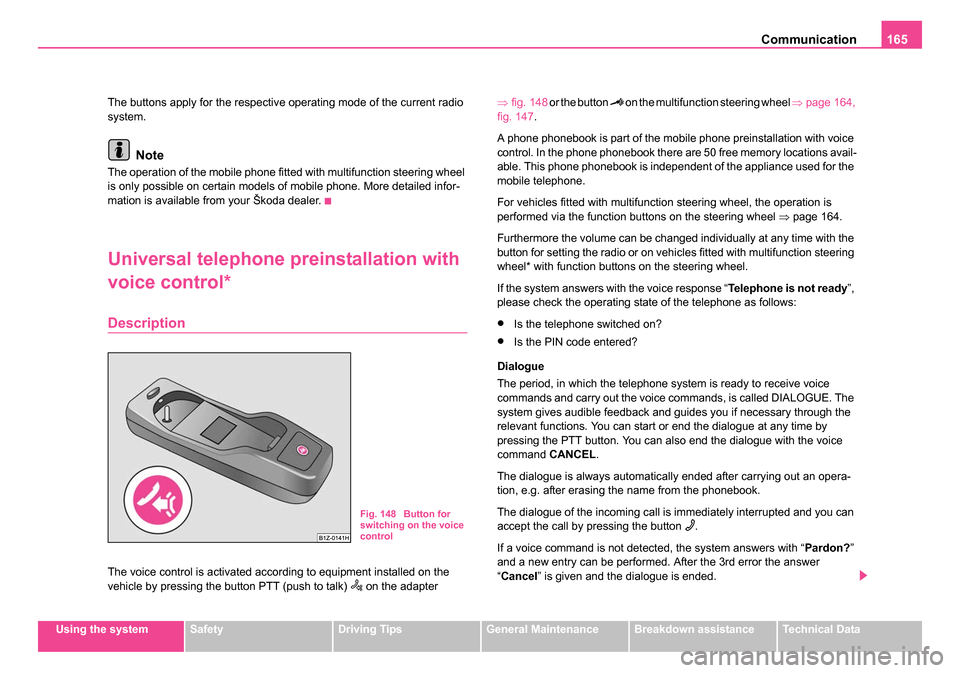
Communication165
Using the systemSafetyDriving TipsGeneral MaintenanceBreakdown assistanceTechnical Data
The buttons apply for the respective operating mode of the current radio
system.
Note
The operation of the mobile phone fitted with multifunction steering wheel
is only possible on certain models of mobile phone. More detailed infor-
mation is available from your Škoda dealer.
Universal telephone preinstallation with
voice control*
Description
The voice control is activated according to equipment installed on the
vehicle by pressing the button PTT (push to talk) on the adapter
⇒
fig. 148 or the button
on the multifunction steering wheel ⇒page 164,
fig. 147 .
A phone phonebook is part of the mobile phone preinstallation with voice
control. In the phone phonebook there are 50 free memory locations avail-
able. This phone phonebook is independent of the appliance used for the
mobile telephone.
For vehicles fitted with multifunction steering wheel, the operation is
performed via the function buttons on the steering wheel ⇒page 164.
Furthermore the volume can be changed individually at any time with the
button for setting the radio or on vehicles fitted with multifunction steering
wheel* with function buttons on the steering wheel.
If the system answers with the voice response “ Telephone is not ready”,
please check the operating state of the telephone as follows:
•Is the telephone switched on?
•Is the PIN code entered?
Dialogue
The period, in which the telephone system is ready to receive voice
commands and carry out the voice commands, is called DIALOGUE. The
system gives audible feedback and guides you if necessary through the
relevant functions. You can start or end the dialogue at any time by
pressing the PTT button. You can also end the dialogue with the voice
command CANCEL.
The dialogue is always automatically ended after carrying out an opera-
tion, e.g. after erasing the name from the phonebook.
The dialogue of the incoming call is immediately interrupted and you can
accept the call by pressing the button
.
If a voice command is not detected, the system answers with “ Pardon?”
and a new entry can be performed. After the 3rd error the answer
“ Cancel ” is given and the dialogue is ended.Fig. 148 Button for
switching on the voice
control
s24s.book Page 165 Thursday, November 24, 2005 12:27 PM
Page 168 of 315
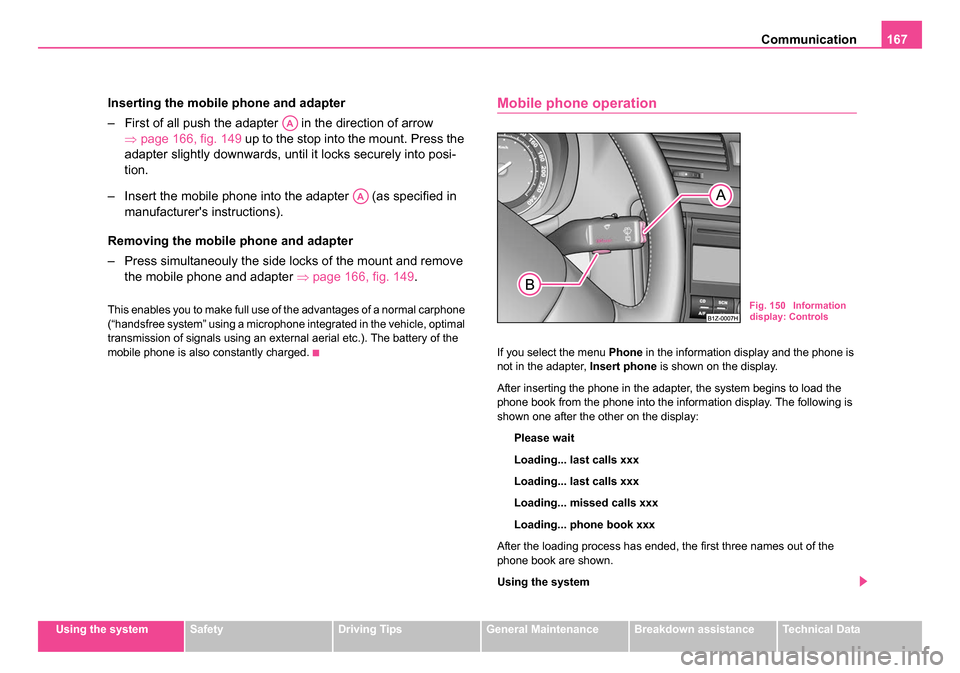
Communication167
Using the systemSafetyDriving TipsGeneral MaintenanceBreakdown assistanceTechnical Data
Inserting the mobile phone and adapter
– First of all push the adapter in the direction of arrow
⇒page 166, fig. 149 up to the stop into the mount. Press the
adapter slightly downwards, until it locks securely into posi-
tion.
– Insert the mobile phone into the adapter (as specified in manufacturer's instructions).
Removing the mobile phone and adapter
– Press simultaneouly the side locks of the mount and remove the mobile phone and adapter ⇒page 166, fig. 149 .
This enables you to make full use of the advantages of a normal carphone
(“handsfree system” using a microphone integrated in the vehicle, optimal
transmission of signals using an external aerial etc.). The battery of the
mobile phone is also constantly charged.
Mobile phone operation
If you select the menu Phone in the information display and the phone is
not in the adapter, Insert phone is shown on the display.
After inserting the phone in the adapter, the system begins to load the
phone book from the phone into the information display. The following is
shown one after the other on the display: Please wait
Loading... last calls xxx
Loading... last calls xxx
Loading... missed calls xxx
Loading... phone book xxx
After the loading process has ended, the first three names out of the
phone book are shown.
Using the system
AA
AA
Fig. 150 Information
display: Controls
s24s.book Page 167 Thursday, November 24, 2005 12:27 PM
Page 170 of 315
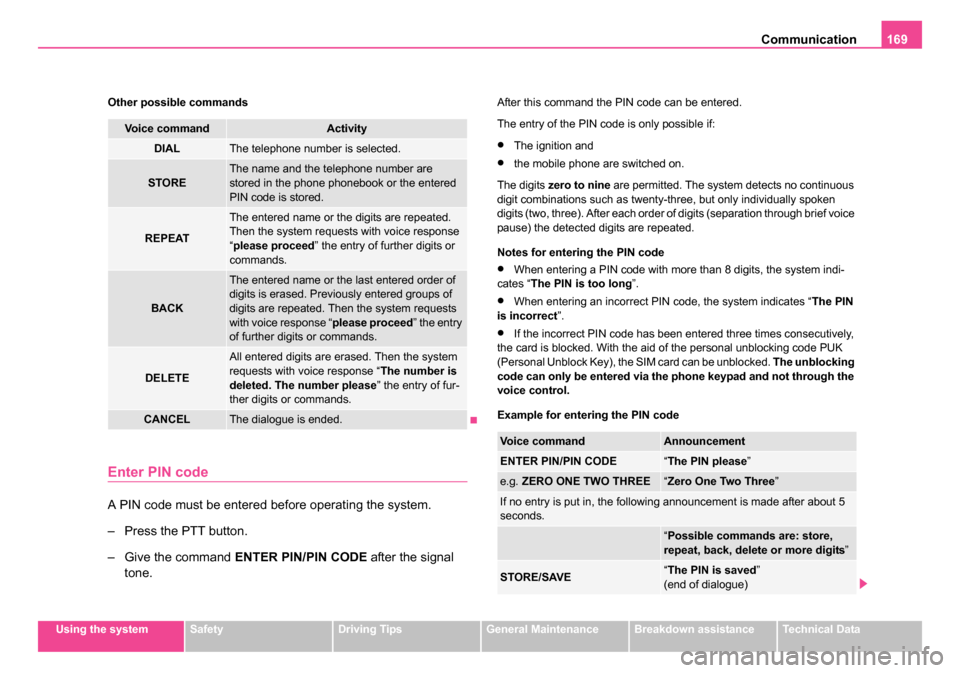
Communication169
Using the systemSafetyDriving TipsGeneral MaintenanceBreakdown assistanceTechnical Data
Other possible commands
Enter PIN code
A PIN code must be entered
before operating the system.
– Press the PTT button.
– Give the command ENTER PIN/PIN CODE after the signal
tone.
After this command the PIN code can be entered.
The entry of the PIN code is only possible if:
•The ignition and
•the mobile phone are switched on.
The digits zero to nine are permitted. The system detects no continuous
digit combinations such as twenty-three, but only individually spoken
digits (two, three). After each order of digits (separation through brief voice
pause) the detected digits are repeated.
Notes for entering the PIN code
•When entering a PIN code with more than 8 digits, the system indi-
cates “ The PIN is too long ”.
•When entering an incorrect PIN code, the system indicates “ The PIN
is incorrect ”.
•If the incorrect PIN code has been entered three times consecutively,
the card is blocked. With the aid of the personal unblocking code PUK
(Personal Unblock Key), the SIM card can be unblocked. The unblocking
code can only be entered via the phone keypad and not through the
voice control.
Example for entering the PIN code
Voice commandActivity
DIALThe telephone number is selected.
STOREThe name and the telephone number are
stored in the phone phonebook or the entered
PIN code is stored.
REPEAT
The entered name or the digits are repeated.
Then the system requests with voice response
“ please proceed ” the entry of further digits or
commands.
BACK
The entered name or the last entered order of
digits is erased. Previously entered groups of
digits are repeated. Then the system requests
with voice response “ please proceed” the entry
of further digits or commands.
DELETE
All entered digits are erased. Then the system
requests with voice response “ The number is
deleted. The number please ” the entry of fur-
ther digits or commands.
CANCELThe dialogue is ended.
Voice commandAnnouncement
ENTER PIN/PIN CODE“ The PIN please ”
e.g. ZERO ONE TWO THREE“Zero One Two Three ”
If no entry is put in, the following announcement is made after about 5
seconds.
“Possible commands are: store,
repeat, back, delete or more digits ”
STORE/SAVE“The PIN is saved ”
(end of dialogue)
s24s.book Page 169 Thursday, November 24, 2005 12:27 PM
Page 172 of 315
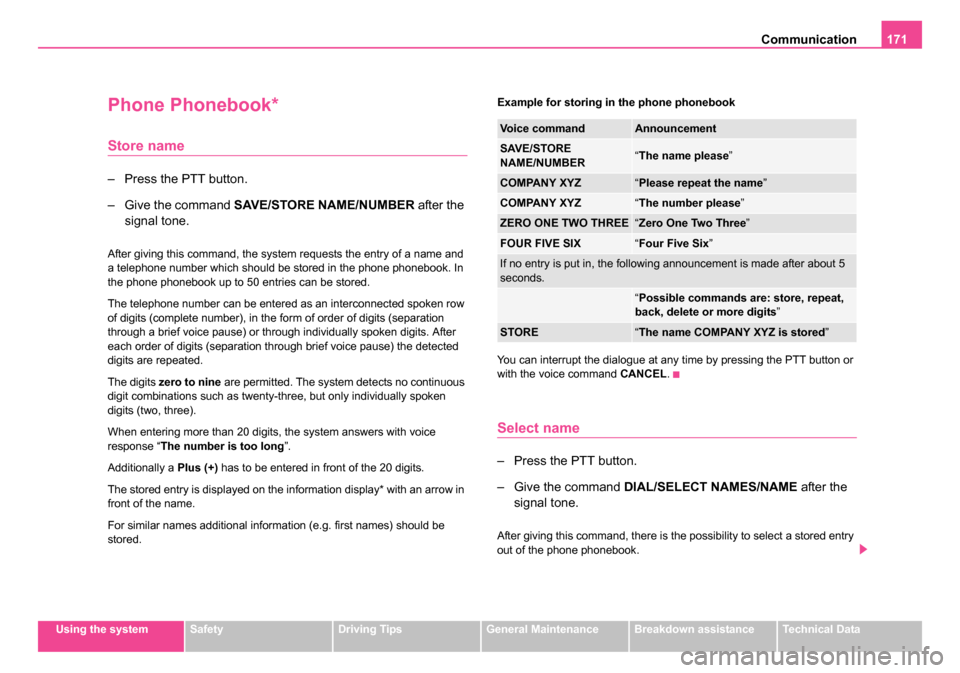
Communication171
Using the systemSafetyDriving TipsGeneral MaintenanceBreakdown assistanceTechnical Data
Phone Phonebook*
Store name
– Press the PTT button.
– Give the command SAVE/STORE NAME/NUMBER after the
signal tone.
After giving this command, the system requests the entry of a name and
a telephone number which should be stored in the phone phonebook. In
the phone phonebook up to 50 entries can be stored.
The telephone number can be entered as an interconnected spoken row
of digits (complete number), in the form of order of digits (separation
through a brief voice pause) or through individually spoken digits. After
each order of digits (separation through brief voice pause) the detected
digits are repeated.
The digits zero to nine are permitted. The system detects no continuous
digit combinations such as twenty-three, but only individually spoken
digits (two, three).
When entering more than 20 digits, the system answers with voice
response “ The number is too long ”.
Additionally a Plus (+) has to be entered in front of the 20 digits.
The stored entry is displayed on the information display* with an arrow in
front of the name.
For similar names additional information (e.g. first names) should be
stored. Example for storing in the phone phonebook
You can interrupt the dialogue at any time by pressing the PTT button or
with the voice command
CANCEL.
Select name
– Press the PTT button.
– Give the command DIAL/SELECT NAMES/NAME after the
signal tone.
After giving this command, there is the possibility to select a stored entry
out of the phone phonebook.
Voice commandAnnouncement
SAVE/STORE
NAME/NUMBER“ The name please ”
COMPANY XYZ“Please repeat the name ”
COMPANY XYZ“The number please”
ZERO ONE TWO THREE“Zero One Two Three ”
FOUR FIVE SIX“Four Five Six”
If no entry is put in, the following announcement is made after about 5
seconds.
“Possible commands are: store, repeat,
back, delete or more digits ”
STORE“The name COMPANY XYZ is stored ”
s24s.book Page 171 Thursday, November 24, 2005 12:27 PM
Page 174 of 315
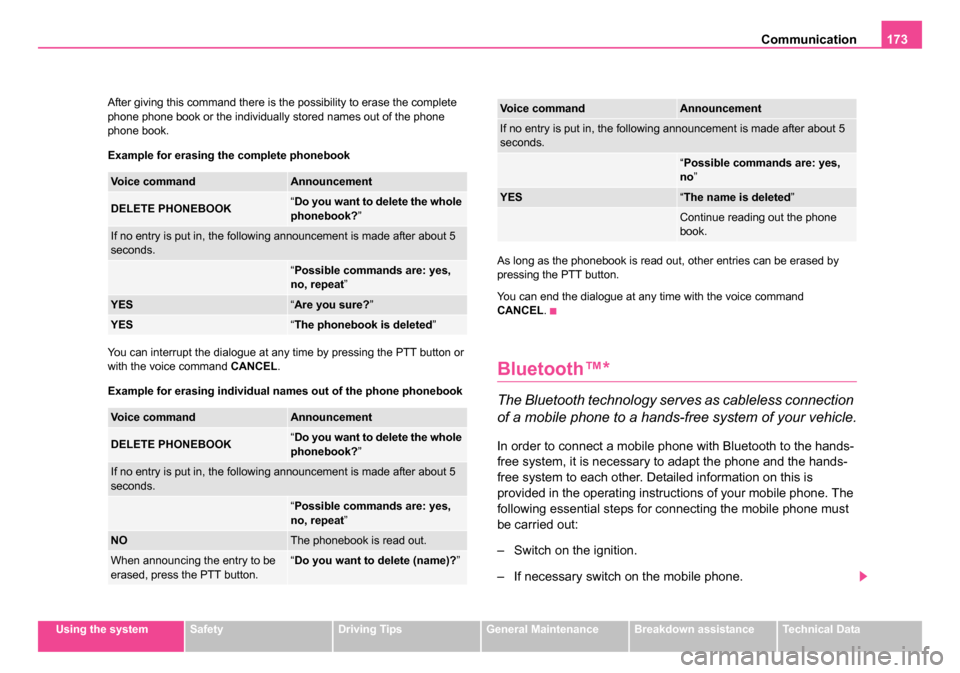
Communication173
Using the systemSafetyDriving TipsGeneral MaintenanceBreakdown assistanceTechnical Data
After giving this command there is the possibility to erase the complete
phone phone book or the individually stored names out of the phone
phone book.
Example for erasing the complete phonebook
You can interrupt the dialogue at any time by pressing the PTT button or
with the voice command
CANCEL.
Example for erasing individual names out of the phone phonebook As long as the phonebook is read out, other entries can be erased by
pressing the PTT button.
You can end the dialogue at any time with the voice command
CANCEL
.
Bluetooth™*
The Bluetooth technology serves as cableless connection
of a mobile phone to a hands-free system of your vehicle.
In order to connect a mobile phone with Bluetooth to the hands-
free system, it is necessary to adapt the phone and the hands-
free system to each other. Detailed information on this is
provided in the operating instructions of your mobile phone. The
following essential steps for connecting the mobile phone must
be carried out:
– Switch on the ignition.
– If necessary switch on the mobile phone.
Voice commandAnnouncement
DELETE PHONEBOOK“Do you want to delete the whole
phonebook? ”
If no entry is put in, the following announcement is made after about 5
seconds.
“Possible commands are: yes,
no, repeat ”
YES“Are you sure? ”
YES“The phonebook is deleted ”
Voice commandAnnouncement
DELETE PHONEBOOK“Do you want to delete the whole
phonebook? ”
If no entry is put in, the following announcement is made after about 5
seconds.
“Possible commands are: yes,
no, repeat ”
NOThe phonebook is read out.
When announcing the entry to be
erased, press the PTT button.“Do you want to delete (name)? ”
If no entry is put in, the following announcement is made after about 5
seconds.
“Possible commands are: yes,
no ”
YES“The name is deleted ”
Continue reading out the phone
book.
Voice commandAnnouncement
s24s.book Page 173 Thursday, November 24, 2005 12:27 PM
Page 176 of 315
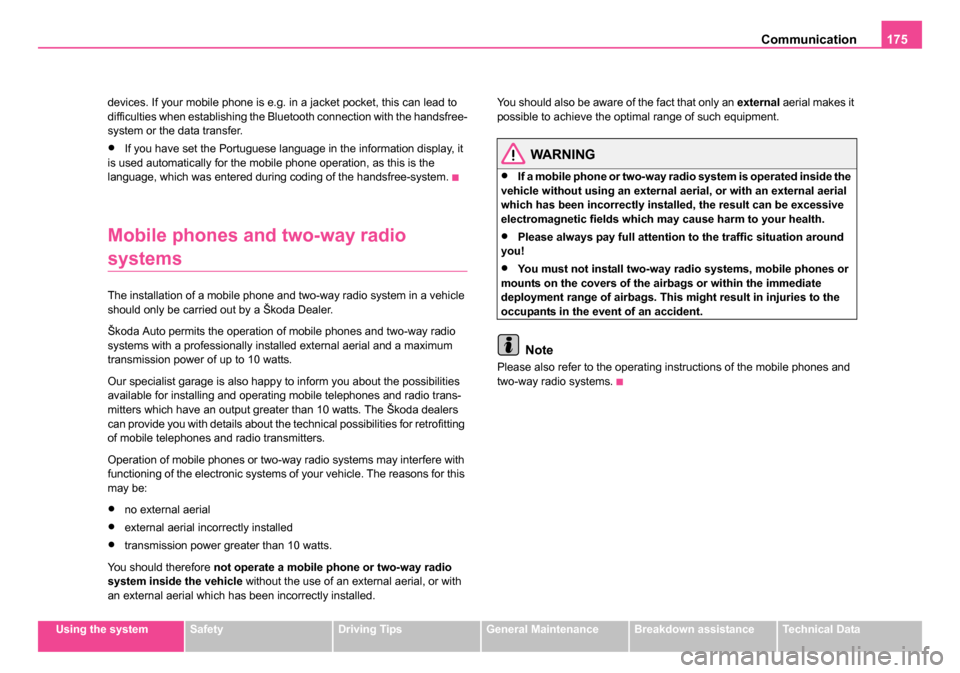
Communication175
Using the systemSafetyDriving TipsGeneral MaintenanceBreakdown assistanceTechnical Data
devices. If your mobile phone is e.g. in a jacket pocket, this can lead to
difficulties when establishing the Bluetooth connection with the handsfree-
system or the data transfer.
•If you have set the Portuguese language in the information display, it
is used automatically for the mobile phone operation, as this is the
language, which was entered during coding of the handsfree-system.
Mobile phones and two-way radio
systems
The installation of a mobile phone and two-way radio system in a vehicle
should only be carried out by a Škoda Dealer.
Škoda Auto permits the operation of mobile phones and two-way radio
systems with a professionally installed external aerial and a maximum
transmission power of up to 10 watts.
Our specialist garage is also happy to inform you about the possibilities
available for installing and operating mobile telephones and radio trans-
mitters which have an output greater than 10 watts. The Škoda dealers
can provide you with details about the technical possibilities for retrofitting
of mobile telephones and radio transmitters.
Operation of mobile phones or two-way radio systems may interfere with
functioning of the electronic systems of your vehicle. The reasons for this
may be:
•no external aerial
•external aerial incorrectly installed
•transmission power greater than 10 watts.
You should therefore not operate a mobile phone or two-way radio
system inside the vehicle without the use of an external aerial, or with
an external aerial which has been incorrectly installed. You should also be aware of the fact that only an
external aerial makes it
possible to achieve the optimal range of such equipment.
WARNING
•If a mobile phone or two-way radio system is operated inside the
vehicle without using an external aerial, or with an external aerial
which has been incorrectly installed, the result can be excessive
electromagnetic fields which may cause harm to your health.
•Please always pay full attention to the traffic situation around
you!
•You must not install two-way radio systems, mobile phones or
mounts on the covers of the airbags or within the immediate
deployment range of airbags. This might result in injuries to the
occupants in the event of an accident.
Note
Please also refer to the operating instructions of the mobile phones and
two-way radio systems.
s24s.book Page 175 Thursday, November 24, 2005 12:27 PM
Page 178 of 315
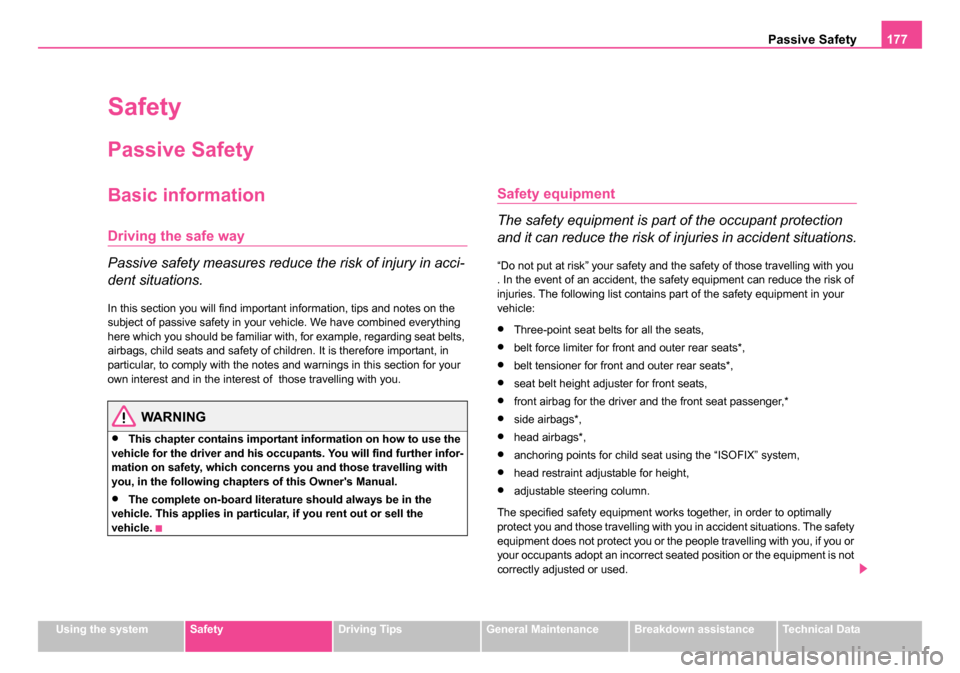
Passive Safety177
Using the systemSafetyDriving TipsGeneral MaintenanceBreakdown assistanceTechnical Data
Safety
Passive Safety
Basic information
Driving the safe way
Passive safety measures reduce the risk of injury in acci-
dent situations.
In this section you will find important information, tips and notes on the
subject of passive safety in your vehicle. We have combined everything
here which you should be familiar with, for example, regarding seat belts,
airbags, child seats and safety of children. It is therefore important, in
particular, to comply with the notes and warnings in this section for your
own interest and in the interest of those travelling with you.
WARNING
•This chapter contains important information on how to use the
vehicle for the driver and his occupants. You will find further infor-
mation on safety, which concerns you and those travelling with
you, in the following chapters of this Owner's Manual.
•The complete on-board literature should always be in the
vehicle. This applies in particular, if you rent out or sell the
vehicle.
Safety equipment
The safety equipment is part of the occupant protection
and it can reduce the risk of injuries in accident situations.
“Do not put at risk” your safety and the safety of those travelling with you
. In the event of an accident, the safety equipment can reduce the risk of
injuries. The following list contains part of the safety equipment in your
vehicle:
•Three-point seat belts for all the seats,
•belt force limiter for front and outer rear seats*,
•belt tensioner for front and outer rear seats*,
•seat belt height adjuster for front seats,
•front airbag for the driver and the front seat passenger,*
•side airbags*,
•head airbags*,
•anchoring points for child seat using the “ISOFIX” system,
•head restraint adjustable for height,
•adjustable steering column.
The specified safety equipment works together, in order to optimally
protect you and those travelling with you in accident situations. The safety
equipment does not protect you or the people travelling with you, if you or
your occupants adopt an incorrect seated position or the equipment is not
correctly adjusted or used.
s24s.book Page 177 Thursday, November 24, 2005 12:27 PM
Page 180 of 315
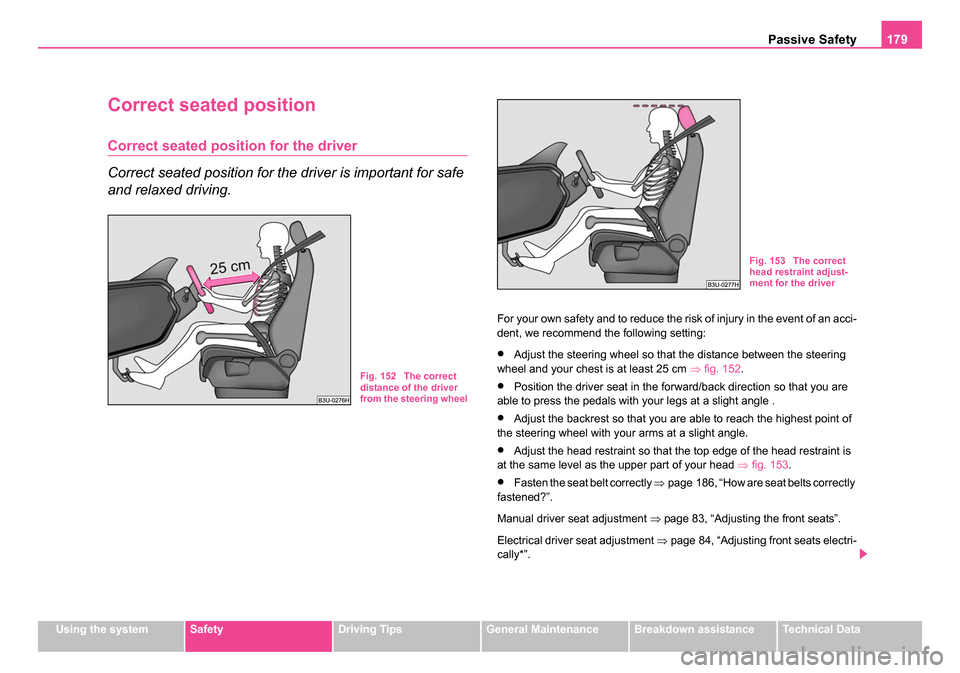
Passive Safety179
Using the systemSafetyDriving TipsGeneral MaintenanceBreakdown assistanceTechnical Data
Correct seated position
Correct seated position for the driver
Correct seated position for the driver is important for safe
and relaxed driving.
For your own safety and to reduce the risk of injury in the event of an acci-
dent, we recommend the following setting:
•Adjust the steering wheel so that the distance between the steering
wheel and your chest is at least 25 cm ⇒fig. 152 .
•Position the driver seat in the forward/back direction so that you are
able to press the pedals with your legs at a slight angle .
•Adjust the backrest so that you are able to reach the highest point of
the steering wheel with your arms at a slight angle.
•Adjust the head restraint so that the top edge of the head restraint is
at the same level as the upper part of your head ⇒fig. 153 .
•Fasten the seat belt correctly ⇒page 186, “How are seat belts correctly
fastened?”.
Manual driver seat adjustment ⇒page 83, “Adjusting the front seats”.
Electrical driver seat adjustment ⇒page 84, “Adjusting front seats electri-
cally*”.
Fig. 152 The correct
distance of the driver
from the steering wheel
Fig. 153 The correct
head restraint adjust-
ment for the driver
s24s.book Page 179 Thursday, November 24, 2005 12:27 PM
Page 182 of 315
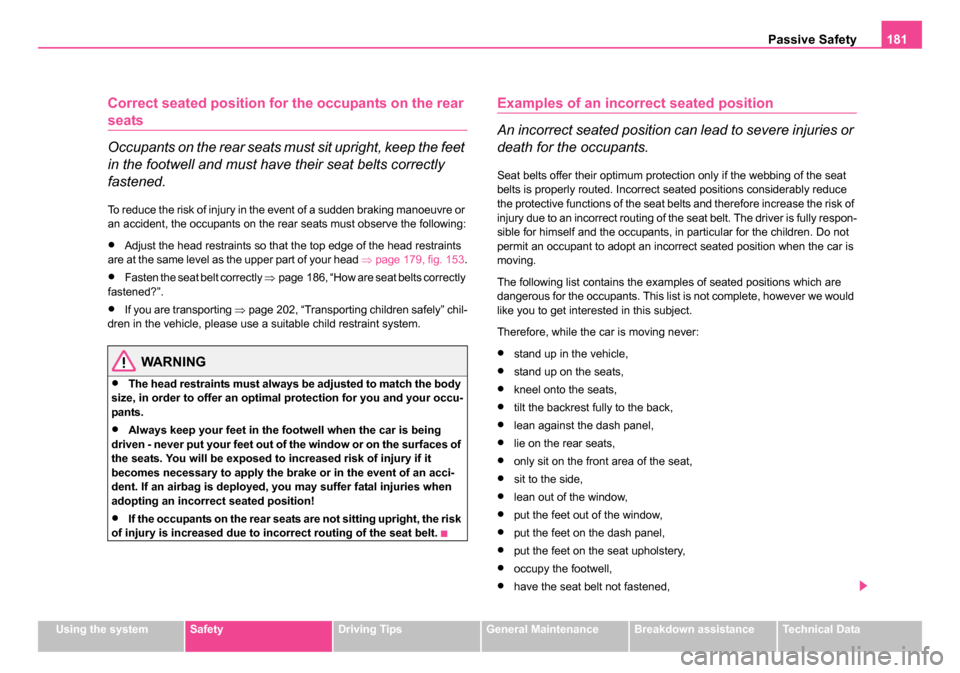
Passive Safety181
Using the systemSafetyDriving TipsGeneral MaintenanceBreakdown assistanceTechnical Data
Correct seated position for th e occupants on the rear
seats
Occupants on the rear seats must sit upright, keep the feet
in the footwell and must have their seat belts correctly
fastened.
To reduce the risk of injury in the event of a sudden braking manoeuvre or
an accident, the occupants on the rear seats must observe the following:
•Adjust the head restraints so that the top edge of the head restraints
are at the same level as the upper part of your head ⇒page 179, fig. 153 .
•Fasten the seat belt correctly ⇒page 186, “How are seat belts correctly
fastened?”.
•If you are transporting ⇒page 202, “Transporting children safely” chil-
dren in the vehicle, please use a suitable child restraint system.
WARNING
•The head restraints must always be adjusted to match the body
size, in order to offer an optimal protection for you and your occu-
pants.
•Always keep your feet in the footwell when the car is being
driven - never put your feet out of the window or on the surfaces of
the seats. You will be exposed to increased risk of injury if it
becomes necessary to apply the brake or in the event of an acci-
dent. If an airbag is deployed, you may suffer fatal injuries when
adopting an incorrect seated position!
•If the occupants on the rear seats are not sitting upright, the risk
of injury is increased due to in correct routing of the seat belt.
Examples of an incorrect seated position
An incorrect seated position can lead to severe injuries or
death for the occupants.
Seat belts offer their optimum protection only if the webbing of the seat
belts is properly routed. Incorrect seated positions considerably reduce
the protective functions of the seat belts and therefore increase the risk of
injury due to an incorrect routing of the seat belt. The driver is fully respon-
sible for himself and the occupants, in particular for the children. Do not
permit an occupant to adopt an incorrect seated position when the car is
moving.
The following list contains the examples of seated positions which are
dangerous for the occupants. This list is not complete, however we would
like you to get interested in this subject.
Therefore, while the car is moving never:
•stand up in the vehicle,
•stand up on the seats,
•kneel onto the seats,
•tilt the backrest fully to the back,
•lean against the dash panel,
•lie on the rear seats,
•only sit on the front area of the seat,
•sit to the side,
•lean out of the window,
•put the feet out of the window,
•put the feet on the dash panel,
•put the feet on the seat upholstery,
•occupy the footwell,
•have the seat belt not fastened,
s24s.book Page 181 Thursday, November 24, 2005 12:27 PM
Page 184 of 315
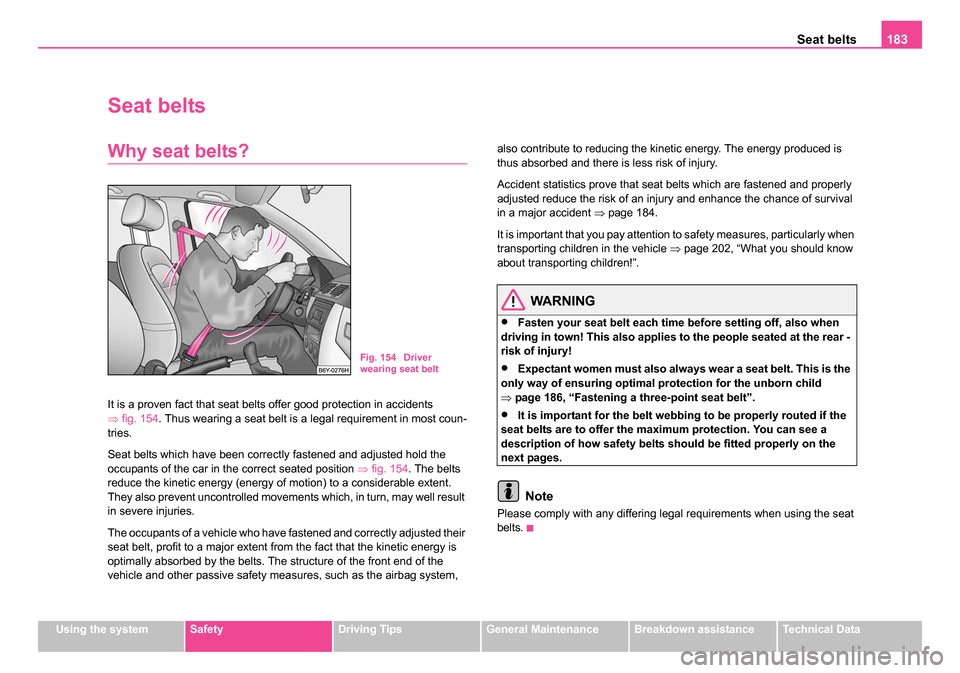
Seat belts183
Using the systemSafetyDriving TipsGeneral MaintenanceBreakdown assistanceTechnical Data
Seat belts
Why seat belts?
It is a proven fact that seat belts offer good protection in accidents
⇒fig. 154 . Thus wearing a seat belt is a legal requirement in most coun-
tries.
Seat belts which have been correctly fastened and adjusted hold the
occupants of the car in the correct seated position ⇒fig. 154 . The belts
reduce the kinetic energy (energy of motion) to a considerable extent.
They also prevent uncontrolled movements which, in turn, may well result
in severe injuries.
The occupants of a vehicle who have fastened and correctly adjusted their
seat belt, profit to a major extent from the fact that the kinetic energy is
optimally absorbed by the belts. The structure of the front end of the
vehicle and other passive safety measures, such as the airbag system, also contribute to reducing the kinetic energy. The energy produced is
thus absorbed and there is less risk of injury.
Accident statistics prove that seat belts which are fastened and properly
adjusted reduce the risk of an injury and enhance the chance of survival
in a major accident
⇒page 184.
It is important that you pay attention to safety measures, particularly when
transporting children in the vehicle ⇒page 202, “What you should know
about transporting children!”.
WARNING
•Fasten your seat belt each time before setting off, also when
driving in town! This also applies to the people seated at the rear -
risk of injury!
•Expectant women must also always wear a seat belt. This is the
only way of ensuring optimal protection for the unborn child
⇒ page 186, “Fastening a three-point seat belt”.
•It is important for the belt webbing to be properly routed if the
seat belts are to offer the maximum protection. You can see a
description of how safety belts should be fitted properly on the
next pages.
Note
Please comply with any differing legal requirements when using the seat
belts.
Fig. 154 Driver
wearing seat belt
s24s.book Page 183 Thursday, November 24, 2005 12:27 PM